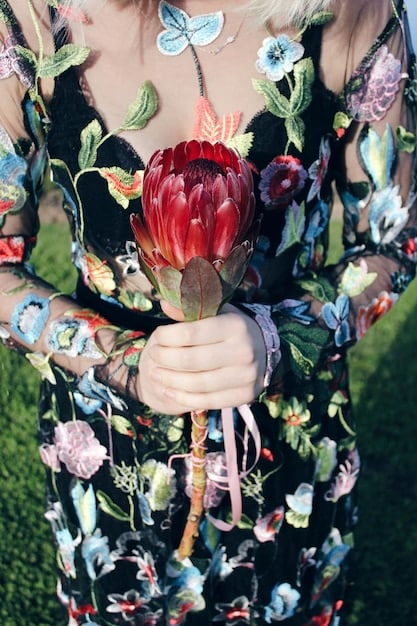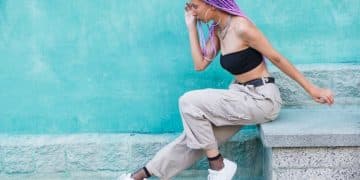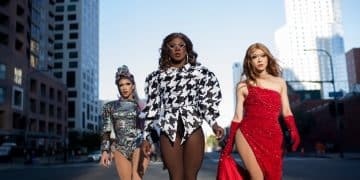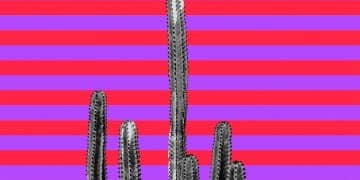Maximalism vs. Minimalism: US Fashion Battle in 2025

The US fashion scene in 2025 is poised for a dynamic interplay between maximalism and minimalism, with neither style achieving outright dominance but rather influencing different consumer segments and occasions, reflecting a nuanced evolution in design preferences and personal expression.
In the ever-evolving landscape of American fashion, a fundamental question emerges for 2025: Will Maximalism vs. Minimalism: Which style will win in the US fashion scene in 2025? This isn’t merely a trend prediction but a deeper look at cultural shifts, consumer desires, and the cyclical nature of design, inviting a closer examination of what defines aesthetic triumph in the coming year.
The enduring appeal of minimalism: A timeless foundation
Minimalism, in fashion, is more than just a lack of embellishment; it’s a philosophy focused on essentialism, quality, and timeless design. Its enduring appeal lies in its versatility and sophistication, offering a sense of calm and clarity amidst an increasingly chaotic world. As we approach 2025, minimalism continues to shape wardrobes and design aesthetics, albeit with subtle shifts.
Defining modern minimalism
Modern minimalism distinguishes itself from its predecessors by embracing new interpretations of classic principles. It’s less about austerity and more about conscious consumption and refined simplicity. Designers are exploring innovative fabrics and subtle detailing to elevate minimalist garments.
- Conscious consumption: Focus on fewer, higher-quality pieces that last.
- Elevated basics: Investment in well-crafted staples like tailored trousers, crisp shirts, and classic outerwear.
- Neutral palettes with pops of color: While still rooted in neutrals, modern minimalism occasionally incorporates muted or earthy tones.
- Understated luxury: Emphasis on impeccable fit, superior materials, and subtle branding.
The allure of minimalism often stems from its ability to project an image of effortless chic. This aesthetic resonates with consumers seeking practicality and longevity in their clothing choices, valuing pieces that transcend fleeting trends. Its adaptability allows for easy mixing and matching, forming the backbone of a versatile wardrobe suitable for various occasions, from professional settings to relaxed weekend wear.
Consumer adoption and lifestyle integration
Minimalism has transcended mere fashion to become a lifestyle choice for many Americans. Its principles align with growing interests in sustainability, mindful living, and decluttering. For consumers, a minimalist wardrobe represents efficiency and purpose.
This integration into daily life suggests that minimalism isn’t merely a passing trend but a deep-seated preference for many, especially those who prioritize functionality and a streamlined existence. The continued demand for well-made, versatile garments indicates a mature market that values investment pieces over fast fashion. This foundational strength makes it a formidable contender in the 2025 fashion landscape.
Ultimately, minimalism in 2025 will continue to thrive as a foundational element of many American wardrobes. It offers a counter-narrative to excess, appealing to those who seek elegance in simplicity and a sustainable approach to personal style. Its timeless qualities ensure its relevance, adapting to modern sensibilities while retaining its core principles of refined understatement.
The vibrant resurgence of maximalism: Bold statements for a new era
Maximalism is making a powerful comeback, characterized by its embrace of excess, vibrant expression, and uninhibited creativity. Far from being a fleeting phenomenon, its resurgence reflects a cultural craving for joy, individuality, and a rejection of sartorial constraints. In 2025, maximalism is poised to offer a refreshing contrast to minimalist tendencies, celebrating personal narratives through audacious fashion choices.
Key characteristics of modern maximalism
Today’s maximalism is a sophisticated blend of eclectic influences, often playing with unexpected combinations. It’s about more is more, but with intention and personality.

- Eclectic mixing: Combining diverse patterns, textures, and eras into one cohesive look.
- Bold color palettes: Unafraid to use vibrant, clashing, or unconventional color combinations.
- Layering and volume: Utilizing multiple layers of clothing, exaggerated silhouettes, and voluminous fabrics.
- Statement accessories: Oversized jewelry, elaborate handbags, embellished footwear, and unique headwear.
- Personal narrative: Dressing as a form of self-expression, telling a story through clothing.
The appeal of maximalism lies in its ability to break free from traditional fashion norms, allowing individuals to weave together disparate elements into a harmonious, yet striking, ensemble. It’s a celebration of abundance, where every detail, no matter how small, contributes to the overall theatricality of the look. This approach encourages a playful experimentation, moving beyond conventional aesthetics to foster a truly unique style.
Why maximalism is gaining traction
Several factors contribute to maximalism’s rising prominence in the US fashion scene. After periods of austerity and uncertainty, there’s a collective desire for optimism and exuberance. Fashion often mirrors the societal mood, and maximalism serves as a joyful antidote.
The digital age, particularly social media platforms like TikTok and Instagram, has become a fertile ground for maximalist expression. These platforms encourage visual storytelling and provide a stage for individuals to showcase their unique, often elaborate, styles. Influencers and content creators actively embrace maximalism, inspiring their followers to experiment with bolder looks.
Moreover, designers are increasingly embracing maximalist aesthetics, pushing boundaries with intricate detailing, vibrant prints, and dramatic silhouettes. This high-fashion endorsement trickles down to mainstream trends, making maximalism more accessible and desirable. The movement is about individual liberation, a rejection of conformity, and an embracing of a highly visual, emotionally rich form of self-expression.
In essence, maximalism in 2025 represents more than just a trend; it’s a cultural shift towards embracing individuality and unrestrained joy through fashion. It allows for unbounded creativity, transforming clothing into wearable art and a declaration of personal style. Its vibrant energy and expressive freedom make it a compelling force in the upcoming fashion year.
Cultural currents influencing 2025 fashion trends
Fashion is rarely an isolated phenomenon; it’s deeply intertwined with broader cultural, social, and economic currents. Understanding these underlying influences is crucial for predicting which style, maximalism or minimalism, might gain an edge in 2025. The US fashion landscape, in particular, is a melting pot of diverse perspectives and rapidly shifting values.
Post-pandemic sartorial shifts
The lingering effects of the pandemic have irrevocably altered consumer behavior and fashion preferences. There’s a heightened appreciation for comfort and practicality, yet also a powerful yearning for joyous self-expression after prolonged periods of confinement. This dichotomy creates fertile ground for both minimalist practicality and maximalist exuberance.
While many embraced loungewear and understated styles during lockdowns, the subsequent reopening spurred a desire for dressing up and making a statement. This pendulum swing means consumers are likely to possess diverse wardrobes, capable of accommodating both understated elegance and bold declarations depending on the occasion and mood.
Sustainability and mindful consumption
An increasingly critical factor is the growing awareness of environmental impact and the desire for more sustainable fashion practices. This trend nominally favors minimalism, with its emphasis on quality over quantity and timeless pieces designed to reduce consumption. However, maximalism is adapting, with a focus on vintage finds, upcycling, and supporting independent designers who prioritize ethical production.
The conversation around sustainability is pushing both aesthetic camps to innovate. Minimalist brands emphasize circularity and durable materials, while maximalists explore slow fashion through intricate, long-lasting pieces and the repurposing of existing garments. This shared commitment to conscious creation, albeit through different means, highlights a mature market that values responsible choices.
The influence of digital culture and social media
Social media platforms continue to be powerful shapers of fashion trends. TikTok, Instagram, and emerging virtual platforms accelerate trend cycles, democratize style, and offer highly visual inspiration. This environment tends to favor maximalism, as bold, unique, and visually striking outfits perform well in short-form video content and curated feeds.
Nevertheless, the “clean girl aesthetic” and “quiet luxury” trends, largely amplified by social media, demonstrate that minimalism also finds its niche within digital spheres, appealing to those seeking an understated, aspirational image. The key is how each style translates into shareable content and aligns with evolving online identities.
The interplay of these cultural forces suggests that 2025 will not see a complete victory for either style, but rather a dynamic push and pull. Consumers are savvier, more discerning, and less likely to conform to a single aesthetic. Instead, fashion will likely reflect a personalized blend, where individuals choose styles that resonate with their values and desired self-presentation.
Emerging designers and established brands: A strategic interplay
The landscape of fashion is constantly shaped by both the innovative spirit of emerging designers and the established influence of legacy brands. In 2025, their strategic interplay will be pivotal in determining the prevailing aesthetic direction in the US fashion scene. Each category brings unique strengths to the table, challenging and influencing the other in a dynamic dance of trends and timelessness.
The role of emerging designers
Emerging designers are often the vanguard of new trends, pushing boundaries and introducing fresh perspectives. They are more agile, experimental, and less constrained by commercial pressures or brand heritage. They are frequently the first to adopt unconventional materials, bold silhouettes, or novel approaches to fashion, often leaning into the maximalist spirit of creativity and self-expression.
These designers often engage directly with niche communities and leverage social media to quickly build buzz. Their innovative collections can serve as a testing ground for concepts that eventually permeate the broader market. For 2025, expect emerging talents to continue disrupting traditional norms, particularly in challenging established notions of what constitutes “good taste” by embracing playful and audacious designs.
Many emerging designers are also at the forefront of sustainable practices and ethical production, integrating these values into their brand identity from the outset. This commitment appeals to a new generation of conscious consumers, influencing both minimalist and maximalist approaches towards more responsible creation.
Established brands and their adaptation strategies
Established brands, with their significant resources, global reach, and loyal customer bases, play a crucial role in legitimizing and mainstreaming trends. While sometimes slower to adapt, they have the power to scale and distribute new aesthetics. In 2025, these brands will likely employ nuanced strategies, often incorporating elements of both maximalism and minimalism into their collections.
Some legacy brands known for their minimalist heritage might introduce subtle maximalist details, such as unexpected textures, bolder accessories, or a pop of vibrant color, to keep their collections fresh without alienating their core clientele. Conversely, brands with an inherently maximalist identity might refine elements to appeal to a broader audience, emphasizing craftsmanship and thoughtful design over sheer volume.
Their adaptive capacity often involves collaborating with emerging designers or artists, injecting new energy and relevance into their established frameworks. This symbiotic relationship allows established brands to stay current, while new talents gain exposure and production capabilities.
The strategic interplay between these two forces creates a vibrant ecosystem. Emerging designers introduce radical ideas, and established brands refine, scale, and disseminate them, making fashion accessible to a wider audience. In 2025, this dynamic will ensure a diverse and exciting fashion landscape, offering choices that span the spectrum from understated elegance to overt flamboyance, catering to every style sensibility.
The evolving consumer: Demographics and psychographics
Understanding the US consumer is paramount when forecasting fashion trends. Beyond simple demographics, psychographics—the study of consumer attitudes, aspirations, and lifestyles—offer deeper insights into what drives purchasing decisions. In 2025, a multi-faceted consumer base will undeniably shape the dominance, or coexistence, of maximalism and minimalism.
The Gen Z and Millennial impact
Gen Z and Millennials are key drivers of current and future fashion trends. Gen Z, digital natives with a strong emphasis on individuality and social justice, often gravitate towards authentic self-expression. Many in this demographic use fashion as a tool for personal identity and political statements, which can lean towards the bold and unconventional aspects of maximalism, or an intentional, curated minimalism that reflects sustainable values.
Millennials, now established consumers, often seek a balance between classic investments and pieces that reflect their evolving personal style. While many appreciate the timelessness and capsule wardrobe approach of minimalism, a growing segment is embracing more expressive and personalized looks, indicating a willingness to experiment with maximalist elements for special occasions or to express individual flair.
Both generations are highly influenced by social media and celebrity culture, but they also value authenticity and purpose-driven brands. This means brands, whether minimalist or maximalist, must clearly articulate their values and resonate with the consumer’s lifestyle.
Lifestyle and purchasing power
Different lifestyles naturally align with different aesthetic preferences. Urban dwellers might favor sleek, minimalist designs for their practicality and sophistication, while those embracing a more creative or leisure-focused lifestyle might explore the expressive freedom of maximalism. Remote work trends have also softened formal dress codes, encouraging more comfort-oriented, yet still stylish, choices.
Purchasing power also plays a role. Minimalism, often associated with higher-quality, investment pieces, might appeal to consumers willing to spend more for longevity. Maximalism, while it can involve luxury items, also thrives on thrifting, upcycling, and mixing high-low pieces, making it accessible across various income brackets and appealing to those with a keen eye for unique finds.
Ultimately, the 2025 US consumer is not monolithic. They are discerning, globally aware, and increasingly prioritize values like sustainability, authenticity, and individuality in their fashion choices. The blend of demographics and psychographics suggests a market ripe for both the understated elegance of minimalism and the vibrant self-expression of maximalism, indicating a future where personal preference and occasion dictate style, rather than a single overarching trend.
The cyclical nature of fashion vs. enduring trends
Fashion is famously cyclical, with trends from past decades making reappearances, often with a modern twist. However, some aesthetics, like minimalism and maximalism, seem to transcend mere cyclical trends, evolving into enduring paradigms. Understanding this dynamic is key to forecasting their longevity and dominance in 2025.
The ebb and flow of trends
Fashion cycles are often driven by cultural shifts, technological advancements, and a collective desire for novelty. We’ve seen an oscillation between periods of austerity and extravagance throughout history. For instance, the minimalism of the 1990s gave way to the bold Y2K aesthetic, which in turn cycled back to more pared-down looks before the current maximalist resurgence.
This cyclical pattern suggests that neither maximalism nor minimalism will ever truly “die out.” Instead, they will recede and re-emerge, adapting to the zeitgeist. In 2025, we are likely witnessing the peak of a maximalist moment, which will inevitably give way to a fresh appreciation for simplicity, or vice-versa, maintaining a constant state of stylistic flux.
Maximalism and minimalism as timeless philosophies
Beyond being mere trends, maximalism and minimalism represent fundamental approaches to design and aesthetics. Minimalism embodies principles of clarity, functionality, and purity of form, making it a foundational element that constantly reasserts its relevance, particularly in response to visual overload.
Maximalism, conversely, embodies expression, opulence, and an unapologetic embrace of decoration. It thrives on individuality and the rejection of constraint, fulfilling a deep human need for adornment and storytelling through attire. These philosophical underpinnings mean they will always find a place in fashion, even if their specific manifestations change.
For 2025, rather than one style winning decisively, it’s more probable that both will continue to exist in a complementary, rather than competitive, relationship. Consumers will draw from both aesthetics, creating hybrid looks that reflect their nuanced preferences. A “minimalist” might add a single maximalist accessory, while a “maximalist” might opt for a cleaner silhouette softened by opulent fabric. The enduring nature of both philosophies ensures their continued presence, evolving within the fashion cycle rather than being completely replaced.
Predicting the winner: A nuanced outlook for 2025
The question of whether maximalism or minimalism will “win” the US fashion scene in 2025 is not straightforward. The reality is likely more complex, reflecting a sophisticated and diverse consumer base that values adaptability and personal expression above strict adherence to a single aesthetic. Rather than a knockout victory, we anticipate a dynamic interplay and coexistence, influenced by context and individual preference.
A co-existence of styles
Fashion in 2025 is poised to be defined by a greater fluidity between these two poles. Designers will continue to explore both aesthetics, often blurring the lines. Collections may feature minimalist staples juxtaposed with maximalist accessories, or incorporate understated elements into otherwise extravagant designs. This hybrid approach reflects a demand for versatility and the ability to transition seamlessly between different looks and occasions.
Consumers are increasingly empowered to curate their own style, picking elements from various trends. A wardrobe in 2025 might contain a sleek minimalist jumpsuit for work, a vibrant maximalist dress for a night out, and a blend of both for casual wear. This personalized approach means neither style will singularly dominate, but rather serve as foundational elements that can be mixed and matched.
The occasion-driven wardrobe
The “winner” will often depend on the context and occasion. For professional settings, minimalism’s clean lines and sophisticated simplicity will likely maintain their strong hold, conveying professionalism and refined taste. For social events, creative endeavors, or expressions of individuality, maximalism will provide the avenue for bold, memorable statements.
The rise of micro-trends and aesthetic niches also supports this co-existence. While some communities might lean heavily into one extreme, the broader fashion landscape will offer a spectrum of choices, catering to varied tastes and lifestyles. Fashion in 2025 is less about conformity and more about authentic self-representation.
Ultimately, the US fashion scene in 2025 will not see one style definitively “win.” Instead, it will be characterized by a rich tapestry where maximalism and minimalism both thrive, influencing different market segments, occasions, and individual preferences. The true victory will be in the consumer’s freedom to choose, blend, and adapt these powerful aesthetics to reflect their unique identity and the nuances of modern life.
| Key Point | Brief Description |
|---|---|
| ✨ Timeless Minimalism | Focuses on quality, functionality, and sophisticated simplicity with evolving interpretations. |
| 🎨 Vibrant Maximalism | Embraces bold expression, eclectic mixes, and personal narrative, driven by a desire for joy. |
| 🔄 Fashion Cycles | Both styles are enduring philosophies, not just fleeting trends, ensuring their continued presence. |
| 🤝 Co-existence | 2025 will likely see both styles coexisting and influencing each other, driven by consumer choice. |
Frequently asked questions about 2025 fashion trends
No, minimalism is evolving beyond austerity. In 2025, it will be defined by elevated basics, innovative textures, and a focus on conscious consumption. It’s about refined simplicity and timeless pieces, appealing to those who appreciate understated elegance and versatility rather than overt statements.
Cultural shifts like the post-pandemic desire for joy and robust individuality are fueling maximalism. Social media platforms also play a significant role, providing a stage for bold visual expression. Consumers are embracing maximalism as a means of personal storytelling and rejection of sartorial constraints.
Absolutely. 2025 fashion will emphasize fluidity and personal expression. Many consumers will blend elements from both styles, such as pairing a minimalist outfit with a bold, maximalist accessory, or vice versa. This hybrid approach allows for greater versatility and reflects individual taste rather than strict trend adherence.
Yes, sustainability is increasingly important across all fashion styles. While minimalism often emphasizes quality over quantity, maximalism incorporates sustainable practices through thrifting, upcycling, and supporting ethical, smaller designers. Both aesthetics are adapting to meet the growing consumer demand for responsible and conscious consumption.
Runways in 2025 will likely feature a balance, with designers exploring both spectrums. High fashion often sets the tone by showcasing extreme interpretations of trends, so you can expect to see both ultra-sleek, minimalist collections and highly ornate, maximalist displays, reflecting the diverse creative directions within the industry.
Conclusion
As we look to the US fashion scene in 2025, the narrative is less about one style definitively “winning” and more about an intriguing dialogue between two powerful aesthetic philosophies: maximalism and minimalism. Both styles, far from being fleeting trends, represent fundamental approaches to self-expression and design that adapt and evolve with cultural shifts. The discerning consumer of 2025 will likely embrace a fluid approach, selecting elements from each style to craft personalized wardrobes that reflect specific occasions, moods, and values. This nuanced coexistence signifies a maturing fashion landscape where individual choice and creative freedom are the ultimate victors, ensuring a vibrant and diverse sartorial future.





